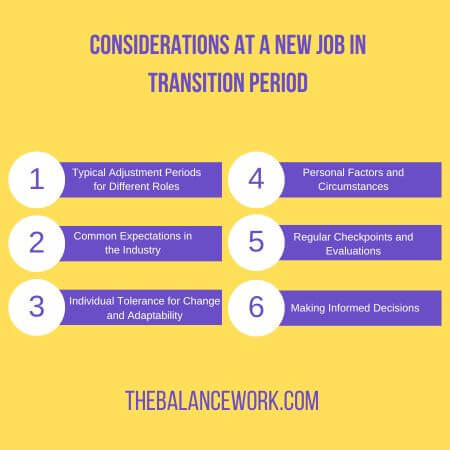How long to give a new job a chance? It is important to consider the duration and give yourself ample time to adapt, grow, and determine whether the job fits you.
This article explores the factors that play a crucial role in determining how long to give a new job a chance.
How Long Do You Give a New Job a Chance- Understanding the Adjustment Period
The adjustment period refers to the initial phase after starting a new job.
You undergo a process of adaptation and familiarization with the job’s requirements, expectations, and work dynamics.
It is a period of transitioning from the unfamiliar to the familiar, and it varies in duration based on individual circumstances and job complexity.
Determining how long to give a new job a chance can vary depending on individual circumstances and the specific nature of the job.
While there is no definitive timeline, giving a new job at least three to six months is generally recommended before making major decisions or evaluations.
This timeframe allows for a sufficient adjustment period.
It allows you to experience different aspects of the job, build relationships, and gain a deeper understanding of the work culture.
6 Factors Influencing the Duration
The nature of the job itself plays a significant role in determining how long to give it a chance. Consider the following factors:
1. Complexity and Learning Curve:
Some jobs may have a steep learning curve, requiring time to grasp new concepts, processes, and technologies.
Complex roles with intricate responsibilities may require more time to understand and perform optimally.

Giving yourself ample time allows skill development and adaptation to the job’s complexities.
2. Skill Set Required:
Jobs that demand specific skill sets or expertise may require additional time to master.
Evaluating your current skill set and identifying any gaps necessary for success in the role can guide your decision-making process.
If the job offers opportunities for skill acquisition or professional development, giving it more time to reap the long-term benefits may be beneficial.
3. Adaptation to Company Values and Norms:
Each organization has its unique values, norms, and work practices. It takes time to understand and adapt to these cultural aspects.
Assess whether your values align with the company’s values and determine if you can integrate into the culture.
4. Relationship Building with Colleagues and Supervisors:
Building relationships within the workplace is crucial for job satisfaction and long-term success.
Developing rapport with colleagues and supervisors takes time and effort.
Assessing the opportunities for collaboration, mentorship, and support within the organization is important.
Investing time in relationship building, you can determine whether the work environment is conducive to your growth and well-being.
5. Skill Acquisition and Career Advancement Opportunities:
Evaluating the potential for acquiring new skills and advancing your career within the organization is essential.
Suppose the job offers opportunities for professional growth, such as training programs, mentoring, or challenging assignments.
In that case, it may be worth giving it a longer chance to see how these opportunities unfold and contribute to your career progression.
6. Assessment of Long-Term Fit and Satisfaction:
Assessing whether the job aligns with your long-term goals and aspirations is crucial.
Consider the level of satisfaction you derive from the work, the industry, and the organization.
Reflecting on your values, interests, and aspirations can help determine if the job has the potential to provide fulfillment in the long run.
Evaluating Job Satisfaction
When evaluating job satisfaction, it is important to consider your initial impressions and expectations.
Assessing the alignment between your job responsibilities and expectations can provide valuable insights. Consider the following factors:
1. Assessing Alignment with Job Responsibilities and Expectations:
Please look closely at your job responsibilities and compare them to what was communicated during the hiring process.
Evaluate whether there is alignment between what you expected and what the job entails.
If there is a significant mismatch, addressing this discrepancy and considering how it may impact your overall satisfaction is important.
2. Managing the Gap between Expectations and Reality:
It is common to have certain expectations when starting a new job. However, the reality of the position may differ from those initial expectations.

It is crucial to manage the gap between expectations and reality effectively.
This can involve seeking clarity from supervisors, engaging in open communication, and adapting your mindset to align with the circumstances.
3. Assessing Work-Life Balance and Stress Levels:
Evaluate how your job impacts your work-life balance and stress levels. A healthy work-life balance is crucial for overall well-being and job satisfaction.
Consider whether your job allows you to balance work and personal life reasonably.
Additionally, assess the stress level you experience about your job.
If the job consistently leads to excessive stress and negatively affects your personal life, it may be a sign of dissatisfaction.
4. Evaluating the Fulfillment of Professional Goals and Values:
Reflect on whether your job fulfills your professional goals and aligns with your values.
Consider if your work contributes to your personal and career growth.
Evaluate whether the organization’s mission and values resonate with your own.
If your job provides growth opportunities and aligns with your values, it will likely contribute to long–term satisfaction and fulfillment.
Regularly assessing these factors and engaging in self-reflection can help you better understand your overall job satisfaction.
Suppose you consistently experience significant dissatisfaction or lack of alignment with your expectations and goals.
In that case, it may be worth considering whether the job fits you in the long term.
Timeframe Considerations
General guidelines and industry standards can influence understanding the timeframe considerations for giving a new job a chance. Consider the following:
1. Understanding Typical Adjustment Periods for Different Roles:
Recognize that the adjustment period can vary based on the nature of the role and industry.
Some positions may require longer onboarding, learning the ropes, and becoming acclimated to the organization’s culture and processes.
Understanding the typical adjustment periods for different roles can help set realistic expectations.
2. Considering Common Expectations in the Industry:
Please consider the common expectations within the industry regarding how long it takes to settle into a new job.
Research industry norms and speak with professionals in the field to gain insights into a reasonable timeframe for giving a new job a chance.
3. Considering Personal Factors and Circumstances:
Reflect on personal factors such as work-life balance, commute, and other obligations outside of work.

These factors can influence how quickly you adapt to a new job and determine how long you are willing to give it a chance.
4. Reflecting on Individual Tolerance for Change and Adaptability:
Consider your tolerance for change and adaptability. Some individuals may adjust quickly to new environments and roles, while others may require more time.
Reflect on your comfort level with change and adaptability to gauge how long you are willing to give a new job a chance.
5. Regular Checkpoints and Evaluations:
Regularly reviewing and reassessing your experience in a new job is essential. Consider the following strategies:
1. Setting Milestones for Self-reflection and Assessment:
Establish milestones or checkpoints to evaluate your progress and satisfaction in the new job periodically.
These can be weekly, monthly, or quarterly assessments to reflect on your experiences, accomplishments, and challenges.
2. Revisiting Initial Expectations and Goals:
Periodically revisit the expectations and goals you had when starting the job.
Evaluate whether they have been met or exceeded or if gaps must be addressed.

This helps clarify what you initially hoped to achieve and whether the job aligns with those expectations.
6. Making Informed Decisions:
When reviewing and reassessing your job, making informed decisions about whether to continue or make a change is important. Consider the following strategies:
1. Weighing the Pros and Cons of Continuing or Making a Change:
Evaluate the pros and cons of continuing in the current job or exploring other opportunities.
Consider factors such as job satisfaction, career growth potential, work-life balance, and alignment with long-term goals.
Weighing these factors can help you make an informed decision.
2. Seeking Advice and Perspectives from Trusted Sources:
Contact trusted sources, such as mentors, colleagues, or career advisors, for advice and perspectives.
Discuss your experiences and concerns with those who can provide valuable insights and guidance.
Their perspectives can help you gain clarity and make a well-informed decision about the duration of your new job.
Conclusion:
In conclusion, determining how long to give a new job a chance is a personal decision influenced by various factors.
It is important to recognize the adjustment period and challenges of starting a new job.
Factors such as the nature of the job, company culture, personal growth opportunities, and job satisfaction play a significant role in determining the duration.
Regular evaluations, effective communication, self-reflection, and considering individual circumstances are crucial in assessing job satisfaction.
Set milestones, reassess expectations, and seek advice.
This way individuals can make informed decisions about continuing in their current job or exploring other opportunities.
Ultimately, finding the right balance between patience and self-awareness is key to giving a new job the chance it deserves.
Last Updated on 1 month by Shahzaib Arshad
- 7 Great Signs Your Boss Wants to Help You - October 8, 2023
- How To Explain Dropping Out Of Law School? Detailed Guide - September 6, 2023
- 10 Reasons Employees Get Fired in Workplace - August 27, 2023
